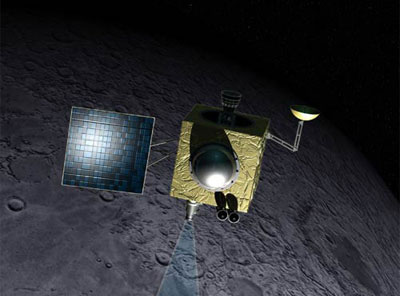 Chandrayaan 1 was a major advance for ISRO, but bigger space exploration plans are in store for the agency. (credit: ISRO) |
Chandrayaan 2 and the evolution of India’s space program
by Taylor Dinerman
Monday, March 16, 2009
India’s space program has come a long way since it was established in 1962 as the Indian National Committee on Space Research (INCOSPAR). Its successor, the Indian Space Research Organisation (ISRO), was set up in 1969, and six years later their first satellite, Aryabhata, was launched. Since then ISRO has matured into one of the “Big Three” Asian space agencies, alongside China’s CNSA and Japan’s JAXA. It is a significant partner in many international space projects.
The first ISRO Moon probe, Chandrayaan 1, was an important step away from ISRO’s previous focus on practical space technology applications, such as remote sensing, communications, distance learning, telemedicine, and security. These efforts were all aimed at supporting India’s national development goals. For many years the feeling was that everything they did had to have a direct payoff for the people and particularly for the impoverished masses. The mission was the first pure space science mission the Indian agency had even done.
The Insat series of communications satellites and the unique weather sensors that they carry are a good example of ISRO’s traditional approach. These satellites were at first launched mostly by Europe’s Ariane and are now being put into orbit by India’s own Geosynchronous Space Launch Vehicle (GSLV). The technology for the spacecraft themselves was almost entirely homegrown. ISRO’s policy was to use as little foreign input as possible, both in order to develop their own industrial base and—so they claimed—to hold down costs.
Chandrayaan 1 represented a major break from that tradition. It incorporated instrument packages from Britain, Germany, Russia, Sweden, and the US, as well as from India itself. This represented a major step forward in India-US cooperation. Overcoming the bureaucratic and political obstacles that have long stood in the way of such bilateral programs was a major achievement for all involved. On the US side breaking through the International Traffic in Arms Regulations (ITAR) restrictions was only accomplished with a lot of hard work on the part of both NASA and the State Department. It would never have been possible without a commitment from the highest levels of government: former President George W. Bush and former Prime Minister A.B. Vajpayee deserve a lot of credit in this regard. In their joint November 2001 communiqué they announced that they had “…agreed to initiate discussions on Civil Space cooperation.”
Chandrayaan 2, scheduled for launch in 2011, is a lander/rover mission that ISRO is developing with some technological input from Russia. This summer they plan to ask the international scientific community for proposals for sensors and experiments to include on the rover. This may be a difficult because the final configuration of the mission has not yet been determined. The rover may weigh anywhere from 30 to 100 kilograms. Obviously there is quite a bit of “trade space” so the proposals, or at least the early ones, will have to include more than a bit of guesswork.
To meet the anticipated launch date India and its partners will have to work within some serious time constraints. By space mission standards 2011 is right around the corner and system integration has got to start as soon as possible. The Indian government has approved funding for the mission and for the advanced version of the GLSV launcher needed to get the probe onto the lunar surface.
Along with their recently announced independent manned space exploration program the Chandrayaan series of science missions show that India is determined to be a space power in the full sense of the term. This flows naturally from India’s emergence as a global economic and political power. Over many decades hundreds of thousands of high-quality scientists and engineers have been trained in Indian universities. These men and women have helped propel India to its new status, and giving them challenging and fascinating new space projects is a way for the Indian government to keep this talent at home and busy.
It will be interesting to see how ISRO uses the Russian technology that they are getting for Chandrayaan 2. We should also keep an eye on the laser imaging system that is being developed for the rover. Integrating these systems into the mission is not going to be easy, but if India pulls it off it will be an even more impressive achievement than Chandrayaan 1.
Taylor Dinerman is an author and journalist based in New York City.
|